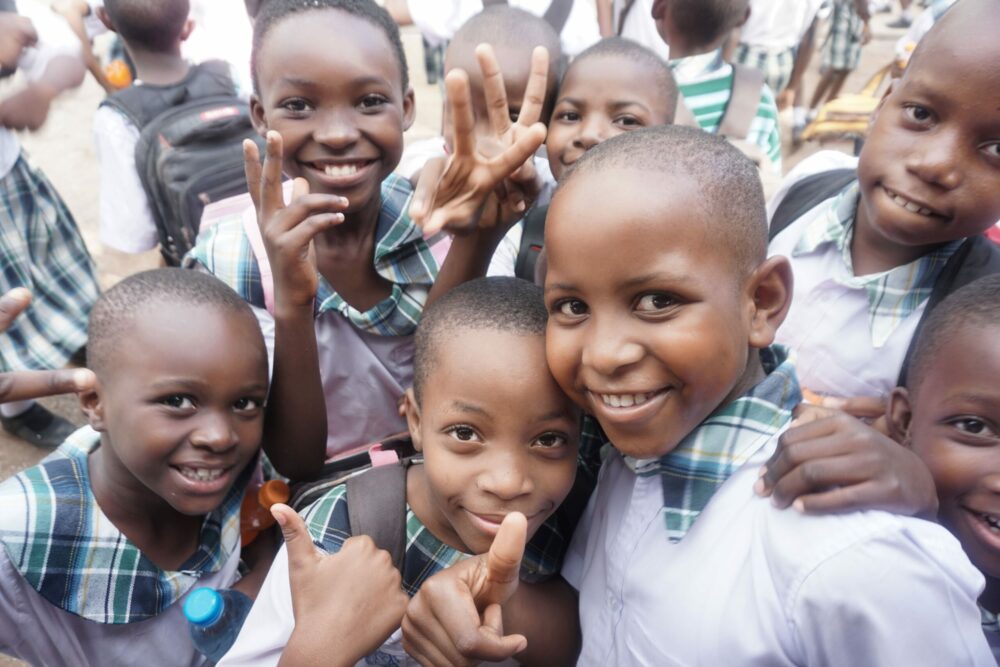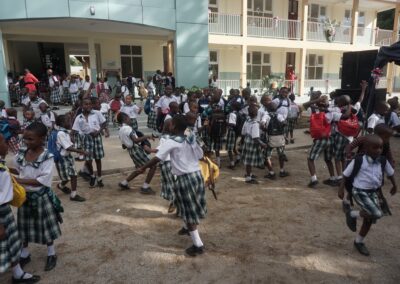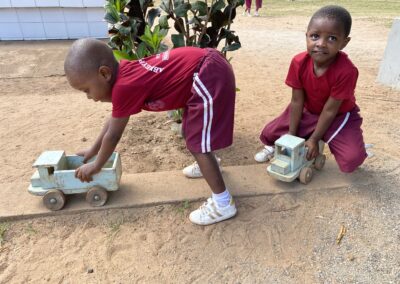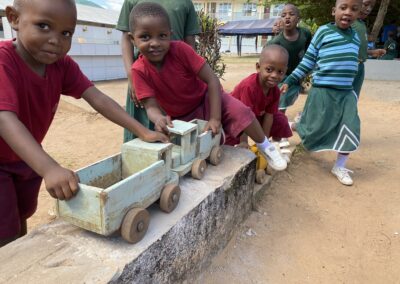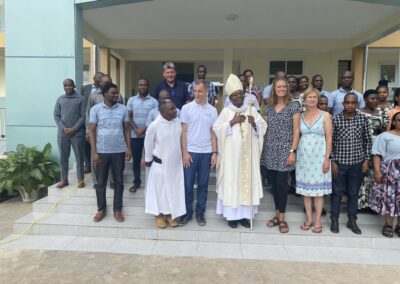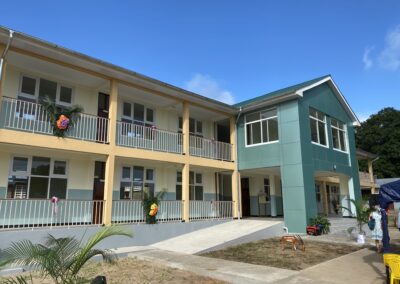Tanzania’s population is growing at a record pace. Compared to 2010, the population has increased by almost 50% from 45 million to currently 65 million. Half of the people there are now 14 years old or younger. The state school system has not been able to keep up with this rapid development and is overwhelmed. In public schools, classes with over 100 pupils are the rule rather than the exception. In addition, there is a lack of schoolbooks, furniture, drinking water and food. As a result, many parents do everything they can to send their children to a school that gives them a real chance of education. This is the case in Ndanda, where the PATRIZIA Foundation has built a new school building for the pre- and primary schools. The new building has created ten additional classrooms, which can now accommodate up to 500 pupils. Dive in and join us on a school visit in the south of Tanzania.
6 am – departure with the school bus
When the first rays of sunlight appear on the horizon, the first children from Mtama are already on the school bus. Every morning it drives them to the Abbey Pre & Primary School. The bus takes about an hour to make the 50 km journey, as it stops again and again on the way to collect more children. Arriving at the school at 7 am, a total of 40 boys and girls tumble out of the bus, which then swiftly moves on to transport children from nearby villages to the school. In total, the school has six school buses that ensure that around 400 children arrive on time at 7.30 am every morning. The school day begins together, with the singing of the national anthem.
The school system in Tanzania
The Abbey Pre & Primary School was founded in 2018 by the Missionary Benedictines in Ndanda. In addition to the three pre-school classes, there are currently grades P1 to P5 in the primary school. “The school has grown steadily over the past few years. Until now, there was no room for more classes,” says Kristian Bollmann from the PATRIZIA Foundation’s Partner and Project Management. “With our new building, we have created the urgently needed ten additional classrooms. This will allow the school to expand to grade P7 and accommodate a total of 280 more pupils.”
8 am – start of classes
Exactly 409 pupils are currently enrolled at Abbey Pre & Primary School. Every morning, attendance is checked and publicly documented. “We take great care to ensure that our students are actually there every day,” says headmistress Theresia Machota. “Our attendance rate is 98% on average. That shows how much parents, children and teachers value school.”
The curriculum includes subjects such as Swahili, English (writing and reading), maths, social studies, science, health education, religion, and physical education. The lessons are taught in English. “This is quite challenging, as many children have to learn Swahili, the national language, in addition to English,” explains the headmistress. “In Tanzania, there are an estimated 120 spoken languages – as many as there are tribes. Children in Tanzania usually grow up with the tribal language as their mother tongue. In the Ndanda region, these are the Makonde, Mahua, and Yao languages. As a result, many children have to learn two new languages when they start school.”
10 am – breakfast break
On an old bicycle rim, the bell rings for break time. In single file, all the children go to the refectory. Here everyone has tea and mandaazi, a kind of doughnut. Afterwards, they finally go to the large schoolyard, where they can let off steam, playing tag, hide-and-seek or swinging.
In between, the children refresh themselves at the water station in the middle of the schoolyard. School director Theresia Machota says: “Fresh and clean water is by no means a matter of course in schools. The water here is enjoyed because it comes from the spring of the Benedictine Abbey and is of drinking water quality.”
11 am – round two
Each lesson lasts 40 minutes. Three lessons are held before the lunch break. A total of 17 teachers are employed at the school – five at the pre-school, eleven at the primary school and Theresia Machota as the school director. The team is also supported by another 13 staff members, working in the kitchen, administration or in the gardens and in building maintenance.
“The commitment of the entire team is visible everywhere,” the PATRIZIA Foundation project manager explains. “Even though the existing buildings were used as a hospital station for a long time, they are still very well maintained and in excellent condition. The same applies to the school grounds, which are very spacious and strikingly green and shaded by old trees.”
1 pm – lunch break
The school’s menu follows a fixed rhythm. While ugali (maize porridge) and ma-kande (maize with beans) are nutritious, filling dishes, pilau (spiced rice with a little meat) is the absolute favourite. This is always served on Thursdays. Unfortunately for the pupils, it’s only on the menu once a week.
“The school fees cover the children’s meals, transport by school bus, school uniform, all costs for lessons such as books, exercise books and pencils, as well as the teachers’ salaries,” the school director says. Officially, public schools do not charge school fees. But that is only half the truth: because of the huge overload, there is too little of everything, so government schools charge special fees by default.”
2 pm – the last session of the day
In the afternoon, religion and sports are taught. Although the school was founded by the Missionary Benedictines and is run by Christians, it is open to all religious denominations. This reflects the peaceful coexistence of Christianity and Islam that is typical for Tanzania: about 60% of the population are Christians, and about 35% Muslims.
The Missionary Benedictine Order has been present in Ndanda for over 100 years. The abbey not only runs kindergartens, schools, a hospital, and training centres, but also serves numerous parishes in the region. For decades, the Benedictines have stood for stability and continuity by being a long-term and secure employer for many people in southern Tanzania. Bollmann: “At the PATRIZIA Foundation, we invest in KinderHaus facilities that we guarantee to operate for at least 25 years. The right project partner is the key to success. With the Benedictines in Ndanda and their abbot Christian Temu, we are in an excellent position.”
This has also been demonstrated in the realisation of the new school building. Construction began in August 2022, and the building was completed in May 2023. “This fast construction time was only possible because we carry out all the work ourselves in our abbey. We not only have our own brickworks or construction department with bricklayers, electricians and carpenters, but also our own carpentry workshop, which built all the school furniture for the new classrooms,” says Abbot Christian Temu. “In addition, the construction of the new school was an absolute priority for our abbey, as the expansion of the school is a real game-changer for the region. Children and young people need a good education so that they will one day have opportunities in the professional world.”
4 pm – home time
For half an hour after the official end of school, the students enjoy time playing with their friends in the schoolyard. At 4.30 pm, the six school buses start for the first time and take the children from the immediate neighbourhood back home. The children who come from further away have a little more time to play. Their return journey starts at 5 pm in Ndanda; the school bus’ second trip. At 6 pm, the children from Mtama are also back home – more or less on time to watch the sunset.
The school system in Tanzania
The school system in Tanzania is based on the British model with a seven-grade primary school, which is mandatory for all children from 7 to 13 years of age. There are also pre-school classes: The pre-school is aimed at children from 4 to 6 years of age. Secondary schools comprise four grades for children aged 14 to 17 (ordinary levels) and two further advanced levels (18 to 19 years), the successful completion of which is required to attend university. In Tanzania, secondary schools are typically boarding schools. This is because the learning environment at home is often difficult, and children can prepare better for exams at school. The boarders only return home during the holidays – in June and December for four weeks each, and in April and September for one week each.
Asante sana!
On 13 May 2023, the official opening ceremony of the new school building, now called PATRIZIA Pre & Primary School Ndanda, took place. As part of the celebration, Abbot Christian Temu consecrated the building along with the ten classrooms. “Together with the pupils we sang, danced and celebrated very heartily from morning to afternoon. It was great fun,” says Kristian Bollmann. “I am happy that we were able to set up this great new building in such a short time. Many thanks to our project partners, the Benedictines, for the great implementation and to all our donor partners who made this project possible through their support. Asante sana, thank you very much!”
Ndanda Abbey
At first glance, the abbey of the Missionary Benedictines of Ndanda does not look very monastic, for the monks are more likely to be found in casual shirts and jeans than in religious habit. They wear their habit mainly at prayer times. The Missionary Benedictines of Ndanda have built up a complete infrastructure in their more than 100 years of presence to maintain the abbey with all its facilities. “We try to make our monasteries largely self-sufficient places. For example, if we waited for the government to build us a new road, we would never get one,” Abbot Christian Temu says. What could be more obvious than to have our own small asphalt production. “This way we can maintain our roads ourselves. It’s cheaper and faster.” It is a similar story with electricity and water. From the idyllically located spring in the middle of the forest, the whole village of Ndanda gets fresh, clean drinking water, which the Missionary Benedictines also market as “Ndanda Abbey Spring Water” in southern Tanzania.
The abbey in Ndanda is one of 55 mission stations of the Benedictines, who have their origins in St. Ottilien near Landsberg am Lech. The German roots are visible and tangible in many places in the monastery. Abbot Christian Temu himself worked at the mother abbey in Bavaria until recently. In March 2021, the monastic community of Ndanda Abbey elected him as its sixth abbot. The Tanzanian-born abbot is now responsible for almost 100 fathers and brothers in the mission station.


